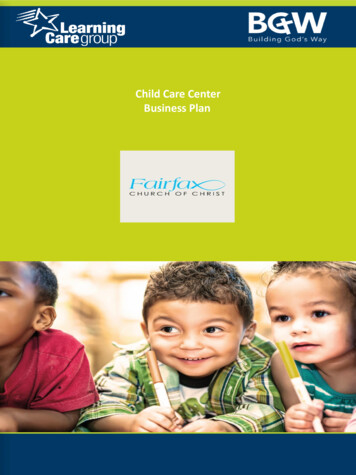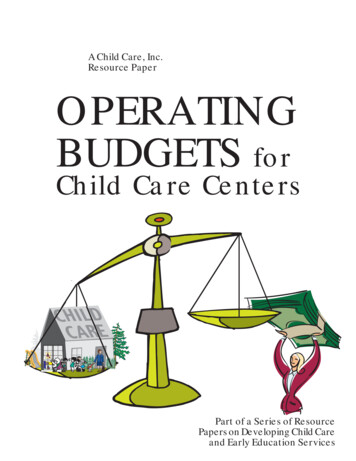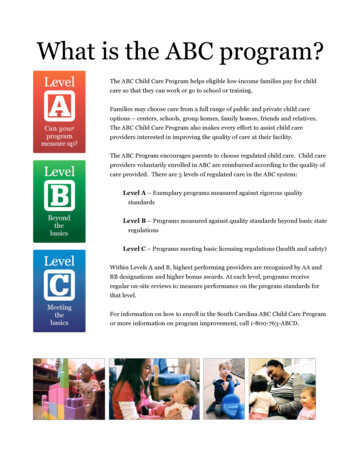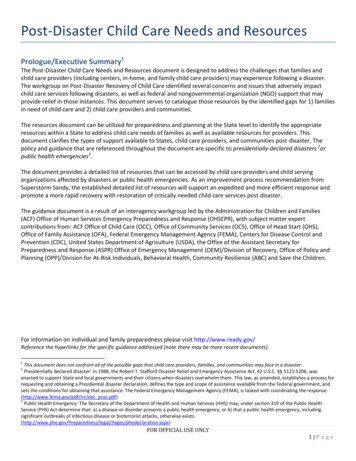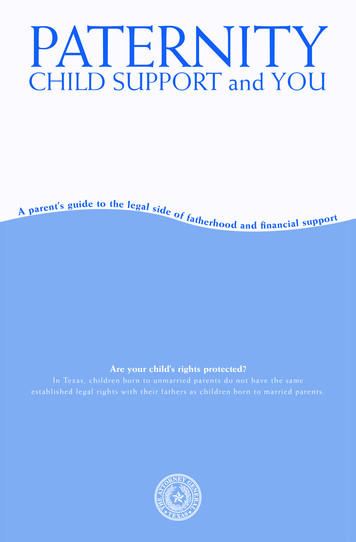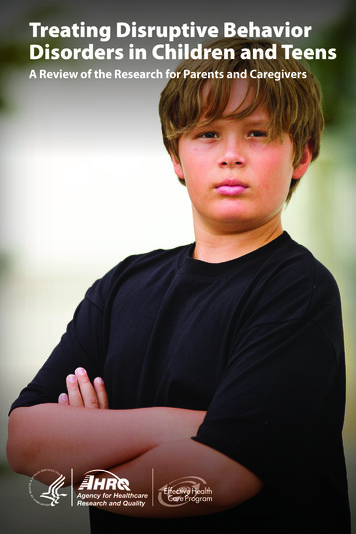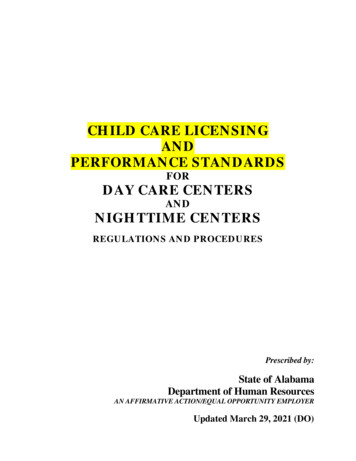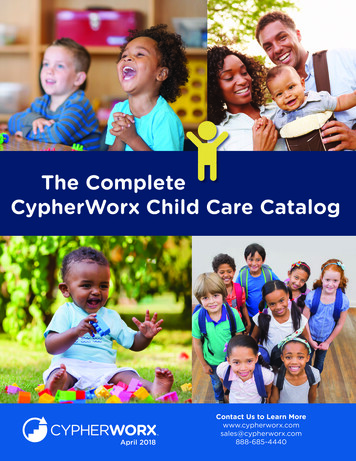
Transcription
The CompleteCypherWorx Child Care CatalogApril 2018Contact Us to Learn 4440
The CypherWorx Child Care CatalogAccessibility30 minutesThis course discusses accessibility in theworkplace, utilizing case studies from theMuseum of Science, Boston for furtherunderstanding. Four main topics are covered:disability etiquette, legal requirements,accomodations, and accessibility and inclusion.Adult and Child CPR1 hourThis course is designed to teach participantshow to properly perform Adult and Child CPR.Participants will learn important definitions,hazards and symptoms to look out for, as wellas the proper way to perform the Heimlichmaneuver.After School Improvement Series: EmergencyAction Plans30 minutesLike all other early childhood and school-agesettings, after school programs need to considerhow they prepare for and respond to emergencysituations, from natural disasters, like storms,earthquakes, tornados, flash floods, or volcaniceruptions; fires; power outages; missing children;or acts of violence, including active shootersituations. Some emergency situations mayrequire evacuation, while others may initiate alock down, or shelter-in-place. The best way toprepare for emergency situations is to plan forthem. We can do this by considering the kindsof emergency situations we might encounter,and then developing a series of proceduresand protocols for responding to them. Yourprogram’s Emergency Action Plan sets out yourrole and responsibilities should any of theseemergencies occur.After School Improvement Series: IndoorEnvironmentsThis webinar will discuss the role a well-plannedindoor environment plays in supporting thedevelopmental needs of school-age children.It will talk about the use of interest areas astools for creating an indoor environment thatsupports children’s interests and developmentalneeds. In addition, we’ll learn how to plan indoorenvironments that are warm and inviting, helpchildren feel welcome and comfortable and willallow them to participate in different activityareas at the same time without disturbing oneanother. And finally, we’ll discuss the role a wellplanned indoor environment plays in keepingchildren safe and engaged.After School Improvement Series: OutdoorEnvironments30 minutesThe After School Improvement Series: OutdoorEnvironments course will describe differenttypes of outdoor environments, along with theopportunities and challenges each one offers;discuss the role outdoor environments playin encouraging children to be active, whilepromoting a range of different experiences;identify the steps you can take to ensure that theoutdoor environment is safe and accessible forall children; explore how outdoor environmentscan be used to extend learning opportunitiesfound in indoor environments.American Heart Association Emergency FirstAid1 hourIt’s important to improve the safety of yourworkers by training them in First Aid, CPR,and AED. In this course, participants will learnsome first aid basics, how to provide First Aidfor some medical, injury, and environmentalinjuries, and how to provide CPR and use anAED. Participants will also learn training optionsthat are available to them through the AmericanHeart Association to get their employees trained.30 minutes2www.cypherworx.com sales@cypherworx.com 888-685-4440
The CypherWorx Child Care CatalogAmericans With Disabilities Act and TransitionPlansBasic First Aid1 hourThis course is designed to give participants theskills they need to perform basic first aid for awide range of injuries and sudden illnesses. Sometopics covered include; the chain of survival,initial assessment, and how to properly bandageand dress wounds. By the end of this courseparticipants will have learned proper first aid forbleeding, shock, burns, chocking, fractures, heartattacks, and much more.Do Title II and Title III of the Americans withDisabilities Act apply to you? Do you workfor a non-profit or for-profit zoo, aquarium, ormuseum? Is your zoo, aquarium, or museumoperated by your state or local government? Doyou have a Transition Plan or Barrier RemovalPlan for your organization? Do you know that theJustice Department or your State’s Attorney’sOffice could sue your organization if you are notin compliance? Fines can cost an organization 55,000 plus compensation just for an initialinfraction. This comprehensive webinar will discussthe development of a plan, examples of that plan,common accessibility issues, and an overview ofwhat to look for in your policies and proceduresthat could cause an accessibility issue.Attention-Deficit/Hyperactivity Disorder (ADHD)15 minutesThe purpose of this course is to educate parents,schools, health professionals and the communityabout evidence-based assessment and treatmentfor ADHD. Participants will learn about ADHD andits features, etiological factors, evidence-basedassessment and treatment, and professionalpractice parameters.Autism and Bullying: A Specialist Module forSchools and the Wider Children’s Workforce15 minutesThe course is designed to give participants anunderstanding of autism and Autism SpectrumConditions, as well as bullying in the contextof autism. Participants will learn a greaterunderstanding of ways to support children withautism in the context of school bullying. By the endthey will have an awareness of some anti-bullyinginterventions that can be implemented in a schoolsetting and feel more able to identify and tacklebullying of children with autism.30 minutesBecome an Energenius 1 hourCalSAC has partnered with the Pacific Gas &Electric Company (PG&E) to bring the Energenius Out-of-School Time Program to our online trainingplatform. This FREE environmental stewardshipcurriculum is designed to engage children andyouth to think about how they use energy, howenergy is measured, paid for, and ways to saveenergy. Children and youth will understand howthey can help reduce the impacts of energy useand production on the environment, and alsopractice influencing others to take energy-savingactions. Additionally, the curriculum is uniquely andintentionally designed to engage families in energyand water conservation habits.Bed Bug Protection Tips15 minutesBed bugs don’t play favorites, anyone can getthem. This course helps participants understandthe characteristics of bed bugs, what the healthrisks are, basic inspection tips, and prevention tipsfor the home, field, and office.Bloodborne Pathogens and HIV (PS)45 minutesIn this course, you will learn about thecharacteristics of bloodborne pathogens, diseasescaused by these pathogens, such as HIV, andhow they are transmitted. You will also learnwww.cypherworx.com sales@cypherworx.com 888-685-44403
The CypherWorx Child Care Catalogthe elements of an exposure control plan andhow to prevent contact with or infection fromcontaminated body fluids. In addition, you willlearn how to handle exposure incidents involvingblood, and the signs, labels, and color-coding usedto warn of biohazards and bloodborne pathogens.This training is provided to help employersprovide a safe and healthful work environment fortheir employees and minimize the possibility ofemployee exposure to bloodborne pathogens.Bringing the Full Power of Science to Bear onDrug Abuse & Addiction30 minutesThe National Institute on Drug Abuse’s (NIDA)mission is to lead the nation in bringing the powerof science to bear on drug abuse and addiction.Recent scientific advances have revolutionizedour understanding of drug abuse and addiction,which is now recognized as a chronic relapsingbrain disease expressed in the form of compulsivebehaviors. This understanding has improved ourability to both prevent and treat addiction. Thiscourse will teach participants the effects of drugabuse and how we can help prevent it.Building Relationships with Children and Youth1 hourAn environment that fosters positive relationshipsbetween children, youth and adults is criticalto creating a high quality program. This coursesupports participants in exploring how to buildpositive, meaningful relationships with children andyouth, in order to plan programs that best meettheir needs.Child Abuse Prevention and Awarenessyou recognize and prevent child abuse within andoutside of program walls. It offers advice abouthow to respond to a child who divulges abusiveinformation and what to do with this information.As someone who works with children you will learnhow to protect the child, your organization, andyourself from accusations of abuse.Child Abuse Prevention and Awareness forSupervisors and Managers90 minutesIf a staff member or volunteer in a child-relatedprogram approaches his or her supervisor witha case of suspected child abuse the supervisormust know how to handle the situation to ensurethe safety of everyone in the program. This courseprovides supervisors with a wealth of informationabout how to recognize and prevent child abusewithin program walls, and furthermore, the stepsto take when a situation of child abuse arises. Inaddition, you will learn best practices for yourself,your staff and your organization.Coaching with Head and Heart45 minutesLeaders and managers need strategies to supportothers in their own growth and development. Inthis course, participants will be introduced to acoaching process that supports individuals tomake more conscious decisions, build off theirstrengths and internal resources and take newaction. Participants will understand when coachingis needed, the mindset required, and the criticalskills needed for effective coaching, including deeplistening and inquiry.90 minutesComing to America: Understanding theImmigration ProcessUnfortunately, child abuse is a prevalent issue intoday’s world. Child care workers and volunteers,coaches, and others who work with children mustbe knowledgeable about the topic to ensurechildren’s safety. This course will make you awareof the many issues related to child abuse and helpImmigrants come to this country under varyingcircumstances, and their journey and immigrationstatus effect how they live and adjust to life inthe U.S. This informational course is designed forparticipants learn more about the immigration430 minuteswww.cypherworx.com sales@cypherworx.com 888-685-4440
The CypherWorx Child Care Catalogexperience and process children, youth, and theirfamilies in their OST programs have gone throughin order to come to the United States. Since manyof our English Learners are immigrants or childrenof immigrants, it is important for us to understandthe circumstances and contexts under which thesechildren, youth, and families are living.Communicating with Families1 hourCommunication and positive relationships withfamilies improve when program staff recognizefamily members as partners. Staff can benefitfrom acknowledging their feelings about familiesand identifying how these feelings help or hinderworking with families. This course providesparticipants the opportunity to identify theirattitudes towards families, consider how theirattitudes can enhance or detract from their abilityto develop positive relationships with families,and examine how a programs overall environmentsupports strong staff-family communication.Community Resource Mapping15 minutesEnglish Learner families can often benefitfrom accessing low-cost/free services such aslegal services, English classes, food banks etc.Afterschool Programs often do not have theresources to provide all of the services that theywould like to provide to English Learners and theirfamilies. This course serves as a compliment toHealthy Cultural Identities and Engaging Familiesand Communities, an in-person training offeredthrough CalSAC’s English Learner Training andProfessional Development Project. This onlinecourse can also be used by a wide audience tohelp participants engage with an example of whatCommunity Resource Mapping looks like.Course 01: Exploring the Continuum ofDevelopmental Tasks of School-Age Children from5 to 12Understanding the continuum of ongoingdevelopment between the ages of 5 and12 provides the foundation for planningand implementing successful school-ageprograms. When staff know and understand thedevelopmental tasks of school-age children, theycan work with children and colleagues to designeffective environments, plan engaging activities,set appropriate expectations and limits, and guidechildren’s behavior effectively.Course 02: Exploring Four Areas of School-AgeDevelopment2 hoursOne of the most helpful ways to gain anunderstanding of the needs and interests of youthbetween 5 and 12 is to examine their developmentfrom four different perspectives: 1) PhysicalDevelopment, 2) Cognitive Development, 3) SocialDevelopment, and 4) Emotional Development. It isimportant for staff to keep all four of these areasin mind when planning and implementing program activities and experiences. Keeping the fourareas of development in mind leads staff to designa balanced set of experiences that nurture andgrowth and development of the “whole child.”Course 03: Exploring Developmental Needs andCharacteristics of Different Age Groups2 hoursCertain developmental needs and traits areassociated with younger school-age children, whileothers are typical of older school-age children andyouth. While the differences between school-agechildren of different ages are not clear-cut, thereare some general traits and tasks that are oftenassociated with younger (ages 5-7), middle (ages8-10), and older (ages 11-12) school-age childrenand youth. Understanding these differences helpsstaff plan appropriate activities and guidancestrategies for children of different ages.2 hourswww.cypherworx.com sales@cypherworx.com 888-685-44405
The CypherWorx Child Care CatalogCourse 04: Exploring Individual Differences inSchool-Age Children2 hoursOne of the most significant challenges for staff inOST programs is learning how to identify, manage,and respond appropriately to individual differencesin a group setting. Some differences amongchildren are the result of inborn characteristics andtraits (e.g. physical characteristics, temperament,talents, race). Other differences are the resultof external factors (e.g. the environment) or arecultivated as the child grows and develops (e.g.interests, skills, knowledge). The diverse needs,characteristics, interests, abilities, and skills ofschool-age children require a flexible atmospherethat supports diversity and choice for childrenwith varying capacities for independent action.Staff who understand and appreciate individualdifferences in children are better equipped to planand implement program experiences that helpindividual children grow and flourish in a groupsetting.Course 05: Guiding School-Age Children inGroups2 hoursWhen large numbers of children are involved inthe program, it is challenging to create and deliverschool-age program activities that can meet theneeds of all children. The key to success is takinga systematic approach to program planning. It isimportant for staff to understand how to selectappropriate activity options and use effectivemanagement strategies that make it possible tooffer a balanced variety of simultaneous activityoptions. This understanding will help staff plan andimplement a program that effectively supports,nurtures, and guides individual differences andfosters positive interaction among children ingroups.Course 06: Guiding the Behavior of IndividualChildren2 hourswill help students develop strategies for creatingprograms that encourage individual children todevelop self-discipline and self-direction, establishpositive relationships with others, and exhibitrespect for program materials and equipment andthe rights of others.Course 07: Observation Skills - What’s Going onHere?2 hoursObservation forms the basis for much of whatpeople plan and do every day. As staff work withchildren in school-age programs, observationtakes a more formal role. High quality school-agecare is based on the principle of developmentallyappropriate practices. Developmentally appropriatepractices combine general knowledge of childdevelopment with specific knowledge of eachindividual child. Conducting objective observationshelp staff learn about each child’s development andprovides staff with valuable information to use inplanning and implementing appropriate programexperiences and in developing effective guidancestrategies.Course 08: Human Relations Skill Development2 hoursBeing able to communicate effectively is anessential human relations skill for school-agecare professionals. To be a good communicator,school-age professionals need to understandthe components of communication and howthe communication process works. They needto identify barriers to clear communication anddevelop strategies for minimizing or eliminatingbarriers to communication. School-age careprofessionals also need to work cooperativelywith other team members to solve problems andconflicts. This requires an understanding of howteams work and the characteristics of effectiveteams. Assessing the current status of personalhuman relations skills helps each professionalidentify priorities for making improvements tothese skills.The knowledge and understanding in this course6www.cypherworx.com sales@cypherworx.com 888-685-4440
The CypherWorx Child Care CatalogCourse 09: School-Age Care as a Family Service Part Oneto be involved in the same way.2 hoursCourse 11: Building Relationships with SchoolPersonnelStrong, positive, cooperative relationships withparents and families are at the heart of qualityschool-age programs. Unfortunately, positiverelationships with parents and families are notalways easy to achieve because parents, likechildren, have widely varying personalities;some are easier to reach than others. Parents inschool-age programs have different ideas, values,concerns, knowledge, pressures, lifestyles, plans,dreams, resources, and constraints. Staff whoare successful in building positive relationshipsbegin by recognizing the importance of acceptingparents as the most important people in children’slives, regardless of differences among them. Theyunderstand that staff attitudes toward parentscan have a strong effect on whether or not staffcan establish positive relationships with parents.Staff in quality programs make a commitmentto learning as much as possible about parents’needs, interests, wants, and concerns and developeffective strategies for making positive connectionswith parents.Course 10: School-Age Care as a Family ServicePart Two2 hoursThe foundation for getting parents involvedin school-age programs is to keep parentswell informed about what is happening in theprogram. Quality programs also provide parentswith opportunities to make suggestions and givefeedback on program services through suggestionboxes, feedback forms, and surveys. When parentsare encouraged to have input in the program, theydevelop trust and confidence in the program andfeel a sense of pride and ownership. They are muchmore likely to participate as resourceful partnerswith program staff when they know their ideasare welcome and valued. Finally, because parentsare all different from each other, it’s important toprovide many different opportunities for them toconnect with the program. Staff in quality schoolage programs recognize that all parents don’t have2 hoursSchool-age programs and schools share a mutualgoal of supporting the growth, development, andlearning of school-age children. Over 50% of allschool-age programs nation-wide are housed inschool facilities. When school-age programs arehoused in school facilities, it is essential for staffin school-age programs to establish and maintaina positive relationship with school personnel. Thismakes it possible for schools and programs to worktogether to support the needs of the whole child.Staff can develop successful partnerships withschool personnel by cultivating an understandingof the needs, interests, and goals of schoolpersonnel and using effective strategies, tools, andsystems to build a spirit of positive collaborationand communication.Course 12: Growing as a Professional in SchoolAge Programs2 hoursCaring for school-age children in a school-ageprogram is a relatively new field of work. Thefield itself is constantly changing and expanding.In view of this “newness” and change, thosewho work in the field are playing an importantrole in shaping and defining what it means tobe a school-age professional. They are guidingschool-age care as an emerging profession. Inthe search for a definition of professionalism inschool-age programs, it is helpful to examine thecommon characteristics of professionalism inother fields. The next step is identifying qualitiesand characteristics associated with professionalbehavior in the school-age field, itself. As a schoolage professional, it is also important to understandthe importance of acting as a public policyadvocate on behalf of school-age children andtheir families. An important part of professionalismis continued personal growth and development inrelation to the field. This requires using appropriatewww.cypherworx.com sales@cypherworx.com 888-685-44407
The CypherWorx Child Care Catalogresources and strategies to further individualprofessional development. It also requiresconsidering what constitutes ethical conduct in thefield and developing an ongoing commitment toethical behavior.Course 13: Creating and Maintaining Safe SchoolAge Environments2 hoursKeeping school-age children safe during outof-school hours is a top priority for school-ageprograms. This requires giving careful attention tosetting up the program environment in a way thatpromotes safety and using effective strategies formonitoring and maintaining a safe environment.Because school-age children are growing towardsindependence, it is also important for staff to helpthem develop habits and behaviors that will keepthem safe from harm as they participate in programexperiences. Promoting and protecting children’ssafety is one of the major responsibilities of staff inschool-age programs.Course 14: Creating and Maintaining HealthySchool-Age Environments2 hoursKeeping school-age children healthy is anothermajor priority for school-age programs. Thisrequires giving careful attention to setting up theenvironment in a way that promotes healthy habitsand using effective strategies for monitoring andmaintaining a hygienic environment. Becauseschool-age children are growing towardsindependence, it is also important to help themdevelop habits and behaviors for living a healthylife-style.Course 15: Designing Effective Indoor School-AgePlay and Learning Environments2 hoursPlanning effective environments is the first step toplanning an effective program. When environmentsare attractive, interesting, and comfortable, theyprovide a backdrop for a varied program that8can address the developmental needs of schoolage children. The look and feel of well-plannedenvironments send messages that let children knowthey are welcome and valued. They are invitingand encourage children to get involved and stayengaged with program activities and experiencesCourse 16: Developing and ImplementingEffective Indoor Interest Areas2 hoursIn order to operate an effective school-ageprogram environment, it is essential for staffto know how to design, set up, and operate avariety of different interest areas that meet thedevelopmental needs of school-age children.Effective interest areas are multi-dimensional; theyprovide a wide variety of activity options withinthe area. Effective interest areas provide childrenwith opportunities to work and play independentlyon their own or with others. They also provide asetting for focused, staff-led activities designed tointroduce children to new concepts and skills. Staffin quality school-age programs know how to workwith colleagues and children to define, develop,and manage a wide variety of interest areasCourse 17: Developing and Implementing EffectiveSchool-Age Outdoor Environments and InterestAreas2 hoursSchool-age children need daily opportunities toexercise, relax, and participate in a wide range ofoutdoor activities. The hours children spend in afterschool programs are often the best hours of theday for getting fresh air and enjoying the out ofdoors while it is still daylight. School-age programscan provide safe, secure settings where childrencan enjoy the out of doors. Even if outdoor spaceis limited, regular participation in a wide variety ofphysical activities in the open air can help childrendevelop healthy exercise habits that will last alifetime.www.cypherworx.com sales@cypherworx.com 888-685-4440
The CypherWorx Child Care CatalogCourse 18: Exploring Effective Schedules, DiverseActivity Formats, Planning Tools, and Staff Roles2 hoursFlexible schedules make it possible to providea varied program of activities that support thedevelopmental needs and interests of schoolage children. By establishing a flexible schedule,school-age staff can plan and implement a varietyof different activity formats. To develop a balancedprogram, it is important for school-age staff totake a systematic approach to both short-termand long-range planning. Staff can use a varietyof different planning tools to plan different typesof activities. To implement a diverse programof activities, it is essential for school-age staffto recognize and use a wide variety of differentroles as they interact with children throughout theprogram day.Course 19: Involving School-Age Children inActivity Planning and Implementation2 hoursAs they grow and change and move towardindependence, school-age children and youthbecome very interested in planning and directingtheir own activities. This means it’s very importantfor staff to think of ways to involve them inprogram planning and implementation. Byplanning activities WITH children instead of FORthem and engaging them in creating the programenvironment, staff can help children develop afeeling of ownership of the program - a positivefeeling that the program belongs to them.Course 20: Developing Activities That EncourageCreativity and Cognitive Development2 hoursChildren who regularly attend school-age programsneed many opportunities to engage in activitiesthat will help them develop their creative potentialand apply their emerging thinking abilities andskills. To support children’s needs, it is essential forschool-age staff to understand the creative processand the relationship of cognitive development tocreativity. With this knowledge and understanding,staff can design and implement a program thatencourages a sense of wonder as children exploretheir environment, fosters creative imagination, andenhances children’s ability to apply reasoning skillsappropriately as they develop ideas and encounterchallenges, problems, and opportunities.Course 21: Creating Successful Clubs, SpecialEvents, and Field Trips in School-Age Programs2 hoursChildren who regularly attend school-age programsneed many opportunities to participate in activitiesthat help them connect with their communitiesand work together to build on their interests,talents, and abilities. Clubs, special events, andfield trips are ideal vehicles for providing theseopportunities. When staff know how to work withchildren to plan and implement these activities,children develop a sense of program ownershipthat helps them become productively engaged ina variety of meaningful activities that support theirdevelopment.Course 22: Developing Activities That SupportCharacter Development and Promote SocialInteraction2 hoursIn order to operate an effective school-ageprogram environment, it is essential for staffto know how to design, set up, and operate avariety of different interest areas that meet thedevelopmental needs of school-age children.Effective interest areas are multi-dimensional; theyprovide a wide variety of activity options withinthe area. Effective interest areas provide childrenwith opportunities to work and play independentlyon their own or with others. They also provide asetting for focused, staff-led activities designed tointroduce children to new concepts and skills. Staffin quality school-age programs know how to workwith colleagues and children to define, develop,and manage a wide variety of interest areas.www.cypherworx.com sales@cypherworx.com 888-685-44409
The CypherWorx Child Care CatalogCourse 23: Providing Homework Support2 hoursThe National Standard Objectives of Learning(SOL) have raised questions about the role ofschool-age programs in providing homework helpand support. Research indicates there are manydifferent ways to provide effective homeworksupport in school-age programs. Some are morestructured than others. When planning a homeworksupport program, it is important for school-ageprograms to develop a homework philosophy thatis consistent with the program’s overall philosophyand reflects current research on best practicesfor providing homework help. The homeworkphilosophy should also reflect the needs of parentsand children in the program and strike a balancebetween homework needs and other experiencesthat help children grow and learn out-of-school.When staff know how to design homeworkenvironments, identify appropriate homeworkmaterials, and use effective strategies to guidechildren’s efforts, homework support can be aneffective component of ongoing programs.Course 24: Helping Children with ADD Succeed inSchool-Age Programs2 hoursChildren with ADD regularly experience strugglesand challenges at home, in school, and in thecommunity. Without the help of knowledgeable,understanding, and supportive people, they oftenexperience multiple failures and frustrations on adaily basis. Typically, they lack the self-confidencethat stems from learning how to do things well.Their lack of social skills and self-control makes ithard for them to make friends with schoolmatesand children they meet in program activities. Bythe school-age years, many of these chi
American Heart Association Emergency First Aid 1 hour It's important to improve the safety of your workers by training them in First Aid, CPR, and AED. In this course, participants will learn some first aid basics, how to provide First Aid for some medical, injury, and environmental injuries, and how to provide CPR and use an AED.

